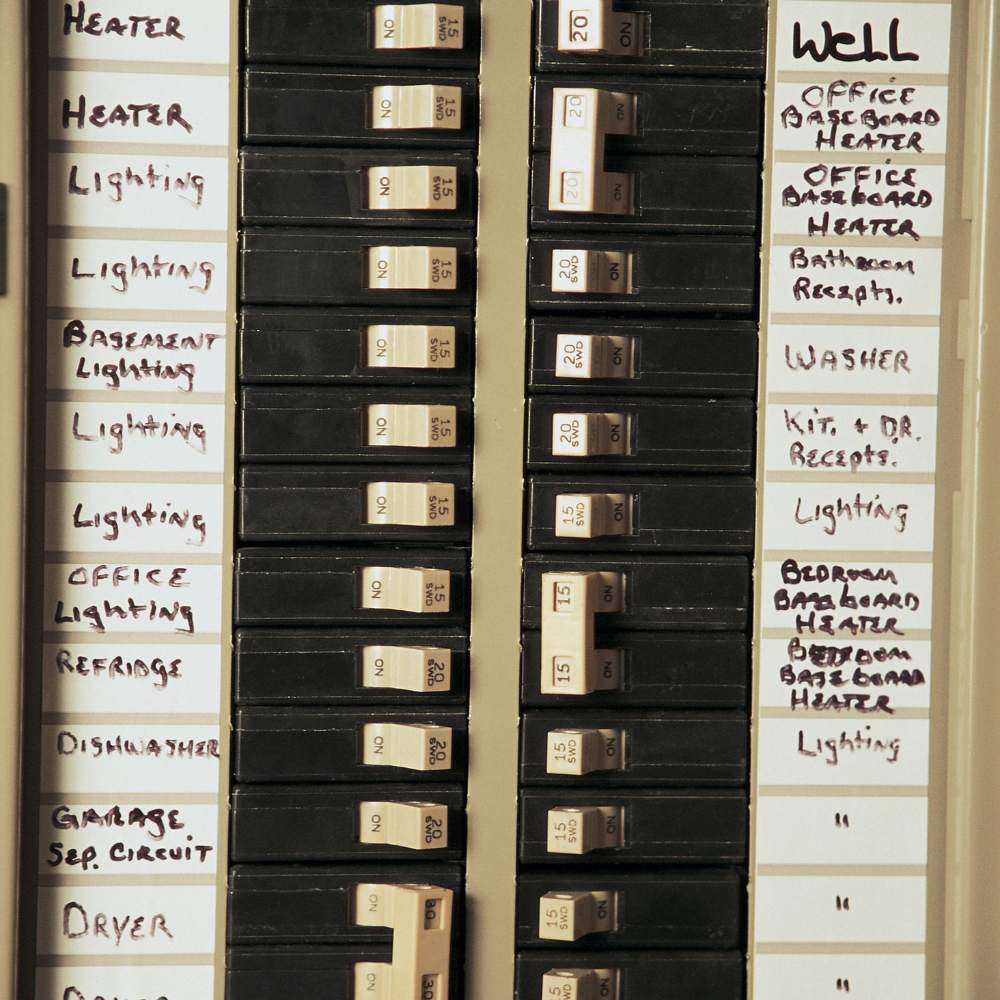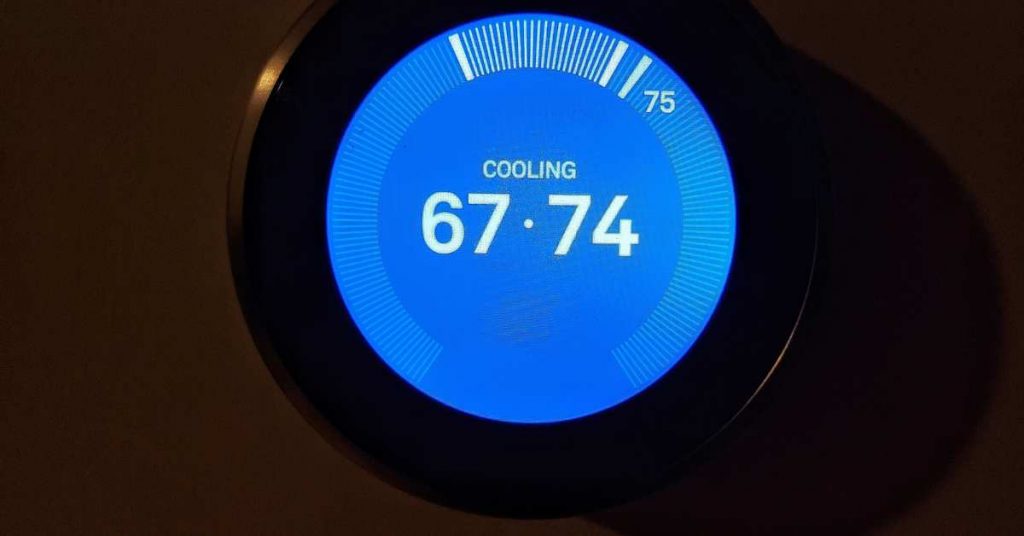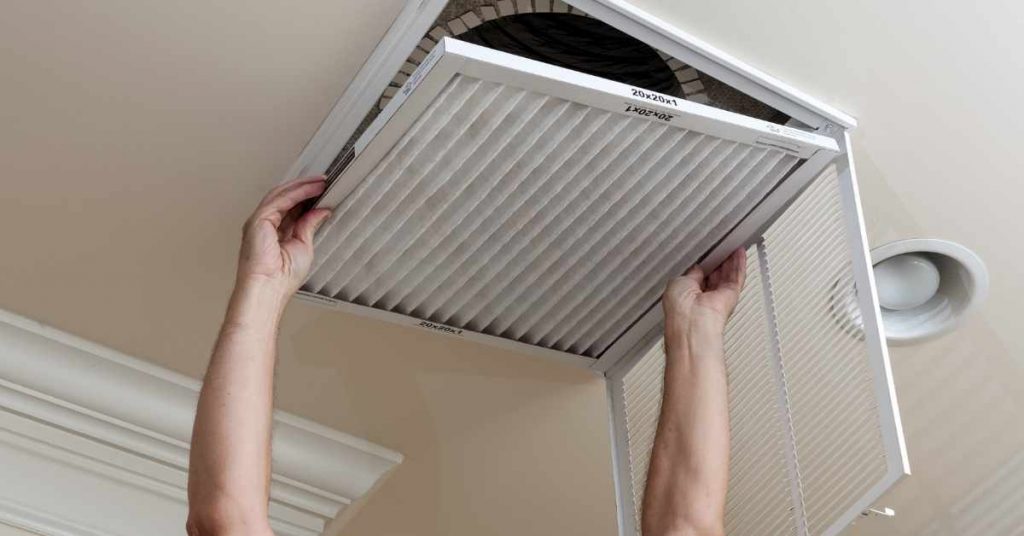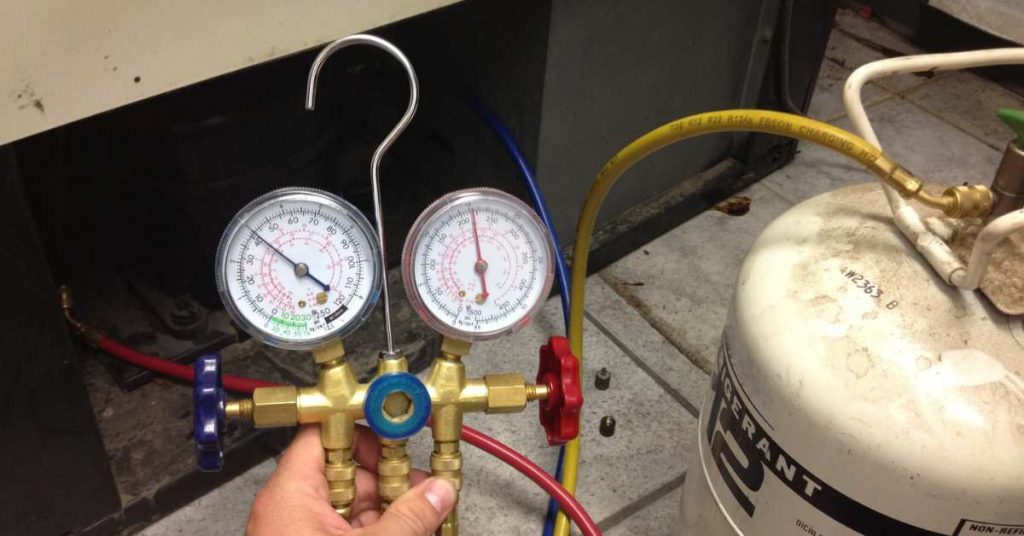An air conditioner that is not cooling is often caused by a dirty filter or a blocked condenser coil, which both restrict the free flow of air. It could also be caused by a frozen evaporator coil, leaking refrigerant, clogged/leaky ducts, blocked AC drain line, tripped breaker, thermostat problems or even bad capacitors.

When your air conditioner (AC) is not cooling, it can be frustrating and uncomfortable, especially during hot weather. This issue can arise due to various reasons, and addressing it promptly is essential to restore the cooling functionality. Here’s a summary of common causes and 11 ways to fix an AC that’s not cooling:
Common Causes
- Dirty Air Filters: Clogged or dirty air filters can restrict airflow, reducing cooling efficiency.
- Thermostat Settings: Incorrect thermostat settings, such as a high temperature setting or the “fan” set to “on,” can hinder cooling.
- Refrigerant Issues: Low refrigerant levels due to leaks or improper charging can lead to poor cooling.
- Condenser Unit Problems: Dirty or blocked condenser coils can limit heat dissipation.
- Frozen Evaporator Coils: Ice buildup on the evaporator coils can disrupt the cooling process.
- Electrical Issues: Faulty capacitors, relays, or wiring can affect the AC’s operation.
- Compressor Issues: A malfunctioning compressor can lead to insufficient cooling.
- Ductwork Problems: Leaks, gaps, or blockages in the ductwork can reduce airflow.
- Insufficient Insulation: Poor insulation in the home can make cooling less effective.
- Obstructed Vents: Closed or obstructed vents can impede airflow.
- AC Unit Size: An undersized AC system may struggle to cool a large space effectively.
11 Ways to Fix an AC Not Cooling
- Change Air Filters: Replace or clean dirty air filters to improve airflow.
- Correct Thermostat Settings: Set the thermostat to the desired temperature and fan mode.
- Check for Refrigerant Leaks: Have a professional technician inspect and repair any leaks.
- Clean the Condenser Coils: Remove debris and dirt from the condenser unit.
- Thaw Frozen Evaporator Coils: Turn off the AC to let the ice melt and address the root cause.
- Inspect Electrical Components: Check capacitors, relays, and wiring for issues, and replace if necessary.
- Compressor Evaluation: Have a technician assess the compressor’s condition and replace if needed.
- Ductwork Inspection: Seal leaks and gaps and remove obstructions in the ductwork.
- Improve Insulation: Enhance insulation in the home to retain cool air better.
- Ensure Open Vents: Make sure all vents are open and unblocked to allow proper airflow.
- Consider System Size: If your AC unit is undersized, consult a professional to assess and possibly upgrade to a larger system.
How to Fix an AC that is Not Cooling
Before you know where to start, you should start by finding out if the problem is with your inside part of the AC system or the outside part. Another thing you should establish if your AC unit is properly plugged in to the power.
The following are the ways to fix an AC that is not cooling in more details:
1. Check if the Breaker Has Tripped or the Fuses Blown

The very first thing you should do once you notice that your AC is not cooling is to check if it is being powered. In case of an overload, the AC will trip the circuit breaker and that could be the reason why it is not cooling the house.
The overload can be caused by failed AC components like motors but could also be causes by dirty filters or leaking refrigerant. If there was a power surge or lightning strikes, that would be another reason for an AC’s breaker to trip.
Dash to your outside unit and check out if the AC is running. If it isn’t, locate the circuit breaker dedicated to your AC from your main breaker panel in the house. If it has tripped, flip it back to the “ON” position.
Two things will happen. The AC will either continue working properly, or the breaker will trip again. If the breaker trips again, you definitely have a problem with one of the AC’s components.
If the breaker is not tripped, make sure that the unit has been plugged in the electrical outlet, and that the power cord from the wall to the unit has not been chewed by rodents or just destroyed by something else.
If all those are good, there should be a breaker on the wall next to the outside unit. Check if it is in the “ON” position as well. If it is but the unit isn’t running, remove the 2 fuses and test them for continuity using a multimeter. If they fail the test replace them.
Tip: You can also check if the unit is receiving the required 240 volts by testing the power across the 2 contactor screws. To locate the contactor you will need to remove the unit’s side panel.
2. Set the Thermostat Correctly

If the unit is being sufficiently powered but will still not cool the house, the other place you should check before moving to other parts is the thermostat. The thermostat is responsible for controlling the indoor temperature by signaling the AC to turn on and off.
First, is the thermostat display on or it is blank? If it is blank, the batteries could be dead. Some thermostats (not all) use batteries and if the batteries are dead it can’t send a signal to the AC to start cooling the house.
Look for clips on the side of the thermostat which you will need to press and slide it out. Locate the dead batteries at the back or the side of the thermostat and replace them. That should fix the problem.
Another thing you want to do is to ensure that the AC is set to cool the house and not heat it. Remember that the thermostat controls the indoor temperature during cooling and heating. As such, you should see “COOL” displayed on the thermostat.
Set the indoor temperature to 5 degrees lower than room temperature. Give the AC sometime and check it will start blowing cold air in the house.
If you have a new air conditioner which is not cooling, there is a good chance that the wires were not properly connected, and the thermostat is sending the wrong signals to the AC unit. In that case you can bring in a technician to fix the problem.
3. Change the Air Filter

When was the last time you changed your air conditioner’s filter? Do you even know where it is located? And do you know that you should replace it after every 3 months or even sooner?
If you have not changed your air filter for a while, that could be the reason why your AC is not cooling the house. Air just can’t pass through a clogged filter and as a result the AC will be forced to work harder, increasing energy bills and can even cause the AC to freeze or other parts to overheat and burn out.
To clean the air in your house, ACs are fitted with an air filter. In central air systems, the filter is located in the return air ducts while in split systems the filter is located inside the indoor unit.
The return air duct is the one that carries warm air from the house to the evaporator coil. On the other hand, the supply air ducts carry cooled air from the evaporator coil to the house.
Dust particles, lint, pollen and other impurities will accumulate on the filter and that is why you need to replace it after 3 months. If you fail to replace the air filter, it will restrict the flow of air to the evaporator coil and as result the AC will not blow cold air in the house.
The first thing you will need to do is locate the filter. There are the places to look:
- Just behind the return air vent grille (see above picture). That can be on the floor, wall or ceiling of your house. Start by removing the grille to access the filter.
- Next to the furnace where the return air duct connects to the unit. You will see a slot with a cover which you will need to remove and slide out the dirty filter.

After locating the filter, the next thing you will need to find out is the size you need. Air filters have different sizes so you need to check the side of the old filter, where the size will be written and order an exact same size.
Air filters are categorized according to their Minimum Efficiency Reporting Value (MERV). For a residential AC, buy an air filter with a MERV rating of between 8 and 12.
While installing the new filter, pay attention to airflow direction. Filters will have an arrow on the side indication the airflow direction. The arrow on the new filter should point towards the evaporator coil/furnace and away from the return air duct.
Tip: When changing the AC filter, start by turning off the AC. That will prevent the dust in the dirty filter from being sucked inside the house.
4. Clean the Condenser Coil
The condenser coil is the one located outside the house, housed together with the compressor. When the refrigerant absorbs heat from the indoor air, it evaporates and flows out to the compressor where it is compressed, a move which also increases its temperature.
From the compressor, the high-temperature refrigerant enters the condenser where it loses the heat to the surrounding air until it turns to a liquid.
To quicken the heat exchange process, the condenser is equipped with a fan which pulls air from the surrounding and forces it across the coil. As the fan is pulling the air, it will pull debris as well and clog the fins which cover the condenser coil.
As more debris is pulled and as it keeps clogging the coil, the refrigerant will fail to lose its heat to the surrounding. In fact, heat is trapped inside the condenser coil and that could be the reason why your air conditioner is not cooling.
Apart from that, check if your condenser unit is obstructed by bushes or other objects such that it cannot properly pull air from the surrounding. The unit needs a foot or more of free space all around it.
If you can clearly see that the condenser unit is dirty, you will need to clean it. You will need a screwdriver or cordless drill, a brush with smooth bristles and a water hose with a nozzle.

- Start by turning off power to the air conditioner. You can do it from the breaker box next to the unit by pulling out the plug or from inside the house.
- Use the screwdriver or drill to remove the panels covering the coil.
- With your bare hands, remove some of the big debris from the coil and then clean it using the brush. While cleaning, brush up and down but not sideways.
- Once you have removed most of the debris with brush, start cleaning using water. Again, spray the water from the top and work your way downwards.
Note: If you have a coil cleaner you can spray it all around the coil and then rinse with water after sometime
- Put back the panels and power the unit
It is always a good idea to clean the condenser coil regularly, especially just before summer starts. A condenser unit cover also helps to prevent debris from clogging the coil when the AC is not being used.
5. Check if the Evaporator Coil is Frozen

A frozen evaporator coil happens in many houses especially when the AC is poorly maintained. But why does an evaporator coil freeze in the first place?
One of the functions of an air conditioner apart from cooling is dehumidification. When the warm and humid air comes into contact with the coil, the moisture in the air condenses and drains outside the house.
However, if the temperature of the refrigerant inside the coil falls below freezing point, the condensate will not drain out but will instead ice over the coil. In fact the entire coil can become a block of ice.
And what causes the evaporator coil to freeze (or the refrigerant temperature to fall below freezing point)? The following:
- Low refrigerant level
- Dirty air filter
- Faulty blower motor/fan
- Clogged or leaking air ducts
- Dirty evaporator coil
Locate your evaporator coil and have look to see if it is frozen. If it is, one of the first thing you should do is turn it off. A frozen coil forces the system to work hard which increases energy consumption and can also cause motors to overheat and fail.
Thawing the ice on a frozen evaporator coil will not make your AC to start cooling again. You should start by finding out why it froze in the first place.
If you notice that apart from being frozen it is dirty, cleaning it is one of the things you should do. Note that an evaporator coil can be dirty and not frozen, which can also restrict airflow and that is why you should clean it regularly as well.
If you want to know how to clean an evaporator coil on your own, check out this video.
We shall look at the other causes of a frozen evaporator coil separately.
6. Check Refrigerant Levels

A refrigerant is the chemical which circulates between the inside and outside AC units (connected using copper pipes) where it absorbs heat from the indoor air and releases it outside.
Since the air conditioning system is sealed (a closed-loop), you don’t need to add refrigerant the way you add gas in your car. Leaks in the system forces people to do it regularly since leaks are not that easy to fix.
For your AC to cool your house properly, the pressure (or amount) of refrigerant in the system needs to be right. If there is a leak somewhere in the system and too much of the refrigerant has leaked out, there will be no way for the indoor air to be cooled.
As a result, the AC will not cool your house, but will instead blow warm air. If your thermostat is properly set to cool and the fan is running properly but the air from the vents is not cold, you could be having low refrigerant levels in the system.
As a homeowner it is very hard to find the source of a leak in your AC, unless it is a major one since refrigerants hardly have a smell. You also cannot measure the amount of refrigerant in the system and even if you can, you need to buy the refrigerant which is only sold to technicians.
All I’m saying is that if a leak in your AC refrigerant line is the cause of your AC not cooling, you will need to hire a technician to fix it for you.
7. Unblock and Open Registers
Your house will have return and supply vents, also known as registers. It is not unusual to find one of the registers closed, especially when folks want to direct cold air elsewhere in the house.
Start by checking if all the registers are opened. If your house has manual dampers to control where cold air flows, make sure they are all opened as well.
Air registers can also clog. To check if that is the case, remove the vent grille and push your hand inside the ductwork. Pull out any gunk that could be clogging it and restricting the free flow of air.
If your registers are located on the walls or floor, make sure that they are not obstructed by furniture or other objects. There should be a free space of a foot or more all around the air register.
8. Unclog or Fix Leaking Ductwork
Both your supply and return air ducts can leak. If not that, they can get clogged by debris or even collapse. If say the supply ducts are leaking out the cold air in the attic, you will arrive at the conclusion that your AC is not cooling the house.
Cleaning clogged ducts or even fixing leaking ones is not a job for the average homeowner. It is best to bring an HVAC technician over and have them fix the job professionally.
Seasoned DIYers can try to locate and fix the leak or clog but for the majority of the people only the pros can do it.
9. Unclog AC Drain Line

As I mentioned, ACs are also responsible for reducing humidity in the house. When the moisture in the air condenses, it drips on a drip pan located under the evaporator coil.
A drain line is then connected to the drip pan to drain the water to the outside. Due to dirt particles and algae inside the drain line, the line will clog at some time, and when that happens, the water in the drip pan will not be drained out.
To prevent the pan from overflowing and damaging the house, a float switch is installed in the pan to turn off power to the thermostat should the level of water in the pan exceed a certain point. And that could be the reason why your AC is not cooling the house.
Fortunately, unclogging an AC drain line is very easy. You only need to remove the cap on the tee near the drip pan and probe it with a thin snake or just pour down some vinegar and let it break down the clog.
Alternatively, you can connect a shop vacuum’s hose to the drain line outside the house and suck out the clog. For more information on how to unclog an AC drain line check out this post.
10. Replace the Capacitor

I forgot to mention this in the beginning but when you go outside to check if the condenser unit is powered up, you will notice one of this 3 scenarios:
- The outside unit is not running.
- Outside unit is running properly and fan is spinning as well.
- The fan is not spinning but the unit is buzzing.
If the outside unit is buzzing but the fan is not spinning, you most likely have a failed capacitor. It could also be the fan motor. Your AC will not cool if the fan is not spinning and you should find out why the fan is not spinning.
To know whether the problem is the motor or capacitor, grab a thin stick or screwdriver and manually turn a fan blade clockwise. If the fan kicks in and keeps on spinning, you have a dead capacitor. On the other hand, if it comes to a stop you have a bad motor.
Other signs of a bad capacitor include humming noises from the outside unit and burning smells as well.
I have written a very detailed article on how to test and replace AC capacitors. Read it here.
11. Replace Failed AC Motors
An air conditioner has 3 motors:
- Blower motor inside the house
- Condenser fan motor
- Compressor motor
These are also some of the most expensive parts of an air conditioner. If any of these motors have failed, the air conditioner will simply not cool the house.
Start inside your house and specifically close to the inside unit where the blower motor is located. Can you hear unusual screeching, grinding or clattering noises from the unit? That is usually a clear sign of a broken motor or fan blade.
With a bad blower motor, the airflow to the house will also be quite weak. It is also accompanied with high energy bills just like is the case when other motors are dying.
On your outside unit, if the condenser fan is not spinning and the problem is not the capacitor then the motor is bad. In old units it could however be a broken or snapped fan belt.
If the compressor motor is bad, you will hear grinding, clattering or high-pitched noises coming from the unit. Bad motors also tend to trip the circuit breaker due to the overheating the system.
As you can already imagine, a bad motor will need to be replaced. In certain instances, an HVAC technician might recommend replacing the entire unit, especially if it is older than 10 years.
And basically those are the reasons why your air conditioner is not cooling, as well as ways to fix it. I hope that by now you know how to fix the AC, or if not, you have an idea what could be the problem.
